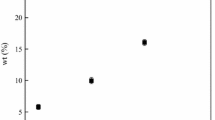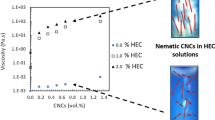Abstract
Tetrabutylammonium acetate (TBAA) solution in dimethyl sulfoxide (DMSO) can dissolve cellulose efficient at a mild condition and it seems to have favorable properties for cellulose molding applications, e.g. fiber spinning. However, if water or other hydrogen bond donors are present, the solvent's ability to dissolve cellulose is greatly reduced. A non-solvent (water) post-added to the cellulose/TBAA/DMSO solutions caused significant changes in flow properties. Specifically, the rheological behaviours of distinct phases formed in 6–8%(w/w) cellulose/TBAA/DMSO solutions due to the addition of water was investigated. With the water concentrations increased, a sol–gel transition had been detected. The Cox–Merz rule and Cross model have been used to fit the rheological data. We explain the sol–gel transformation in cellulose/TBAA/DMSO/water solutions by percolation theory. Meanwhile, a mechanism of cellulose aggregation and the sol–gel transitions have been proposed: water can effectively break the cellulose–Ac− H-bonds and lead to the formation of cellulose–cellulose H-bonds, which grow the aggregation of cellulose, form a network structure in the whole sample and then result in gelation.
Graphic abstract
Sol-gel transition of cellulose/tetrabutylammonium acetate/dimethyl sulfoxide solutions with different water concentrations.







Similar content being viewed by others
References
Bai L, Huan S, Xiang W, Rojas OJ (2018) Pickering emulsions by combining cellulose nanofibrils and nanocrystals: phase behavior and depletion stabilization. Green Chem 20:1571–1582
Bengtsson J, Olsson C, Hedlund A, Kohnke T, Bialik E (2017) Understanding the inhibiting effect of small-molecule hydrogen bond donors on the solubility of cellulose in tetrabutylammonium acetate/DMSO. J Phys Chem B 121:11241–11248
Boukany PE, Hu YT, Wang S-Q (2008) Observations of wall slip and shear banding in an entangled DNA solution. Macromolecules 41(7):2644–2650
Broadbent SR, Hammersley JM (1957) Percolation processes: I. Crystals and mazes. Math Proc Cambridge Philos Soc 53:629–641d
Chang H, Chien A-T, Liu HC, Wang P-H, Newcomb BA, Kumar S (2015) Gel spinning of polyacrylonitrile/cellulose nanocrystal composite fibers. ACS Biomater Sci Eng1:610–616
Chen X, Liang S, Wang S-W, Colby RH (2018) Linear viscoelastic response and steady shear viscosity of native cellulose in 1-ethyl-3-methylimidazolium methylphosphonate. J Rheol 62:81–87
Chen X, Zhang Y, Wang H, Wang S-W, Liang S, Colby RH (2011) Solution rheology of cellulose in 1-butyl-3-methyl imidazolium chlorid. J Rheol 55:485–494
Clasen C, Kulicke WM (2001) Determination of viscoelastic and rheo-optical material functions of water-soluble cellulose derivatives. Prog Polymer Sci 6:1839–1919
Cox WP, Merz EH (1958) Correlation of dynamic and steady flow viscosities. J Polymer Sci 28:619–622
Cross MM (1965) Rheology of non-Newtonian fluids: a new flow equation for pseudoplastic systems. J Colloid Sci 20:417–437
Djabourov M, Leblond J, Papon P (1988) Gelation of aqueous gelatin solutions. II. Rheology of the sol-gel transition. J Phys 49:333–343
Donkor ON, Henriksson A, Vasiljevic T, Shah NP (2007) Rheological properties and sensory characteristics of set-type soy yogurt. J Agric Food Chem 55:9868–9876
Dorris A, Gray DG (2012) Gelation of cellulose nanocrystal suspensions in glycerol. Cellulose 19:687–694
Emam HE (2018) Generic strategies for functionalization of cellulosic textiles with metal salts. Cellulose 26:1431–1447
Ferry JD (1980) Viscoelastic properies of polymers, vol 15. Wiley, New York
Gericke M, Fardim P, Heinze T (2012) Ionic liquids–promising but challenging solvents for homogeneous derivatization of cellulose. Molecules 17:7458–7502
Gubitosi M, Duarte H, Gentile L, Olsson U, Medronho B (2016) On cellulose dissolution and aggregation in aqueous tetrabutylammonium hydroxide. Biomacromol 17:2873–2881
Gupta KM, Hu Z, Jiang J (2013) Cellulose regeneration from a cellulose/ionic liquid mixture: the role of anti-solvents. RSC Adv 3:12794–12801
Hauru LKJ, Hummel M, King AWT, Kilpeläinen I, Sixta H (2012) Role of solvent parameters in the regeneration of cellulose from ionic liquid solutions. Biomacromolecule 13:2896–2905
Haward SJ, Sharma V, Butts CP, McKinley GH, Rahatekar SS (2012) Shear and extensional rheology of cellulose/ionic liquid solutions. Biomacromolecule 13:1688–1699
Hong W, Xu G, Ou X, Sun W, Wang T, Tong Z (2018) Colloidal probe dynamics in gelatin solution during the sol-gel transition. Soft Matter 14:3694–3703
Huang Y-B, Xin P-P, Li J-X, Shao Y-Y, Huang C-B, Pan H (2016) Room-temperature dissolution and mechanistic investigation of cellulose in a tetra-butylammonium acetate/dimethyl sulfoxide system. ACS Sust Chem Eng 4:2286–2294
Idström A et al (2017) On the dissolution of cellulose in tetrabutylammonium acetate/dimethyl sulfoxide: a frustrated solvent. Cellulose 24:3645–3657
Isik M, Sardon H, Mecerreyes D (2014) Ionic liquids and cellulose: dissolution, chemical modification and preparation of new cellulosic materials. Int J Mol Sci 15:11922–11940
Jiang Z, Chen D, Yu Y, Miao J, Liu Y, Zhang L (2017) Composite fibers prepared from multi-walled carbon nanotubes/cellulose dispersed/dissolved in ammonium/dimethyl sulfoxide mixed solvent. RSC Adv 7:2186–2192
Jiang Z, Miao J, Yu Y, Zhang L (2016) Effective preparation of bamboo cellulose fibers in quaternary ammonium/DMSO solvent. BioResources 11:4536–4549
Jiang Z, Tang L, Gao X, Zhang W, Ma J, Zhang L (2019) Solvent regulation approach for preparing cellulose-nanocrystal-reinforced regenerated cellulose fibers and their properties. ACS Omega 4:2001–2008
Keleşoğlu S, Pettersen BH, Sjöblom J (2012) Flow properties of water-in-North Sea heavy crude oil emulsions. J Petrol Sci Eng 100:14–23
Kouda T, Yano H, Yoshinaga F, Kaminoyama M, Kamiwano M (1996) Characterization of non-newtonian behavior during mixing of bacterial cellulose in a bioreactor. J Fermentation Bioeng 82:382–386
Le KA, Sescousse R, Budtova T (2011) Influence of water on cellulose-EMIMAc solution properties: a viscometric study. Cellulose 19:45–54
Lee YJ, Kwon MK, Lee SJ, Jeong SW, Kim H-C, Oh TH, Lee SG (2017) Influence of water on phase transition and rheological behavior of cellulose/ionic liquid/water ternary systems. J Appl Polym Sci 134:44658
Li K, Peng J, Turng L-S, Huang H-X (2011) Dynamic rheological behavior and morphology of polylactide/poly(butylenes adipate-co-terephthalate) blends with various composition ratios. Adv Polymer Technol 30:150–157
Liu S, Li H, Tang B, Bi S, Li L (2016) Scaling law and microstructure of alginate hydrogel. Carbohydr Polym 135:101–109
Liu X, Chang PR, Zheng P, Anderson DP, Ma X (2015) Porous cellulose facilitated by ionic liquid [BMIM]Cl: fabrication, characterization, and modification. Cellulose 22:709–715
Lu F, Song J, Cheng B-W, Ji X-J, Wang L-J (2013) Viscoelasticity and rheology in the regimes from dilute to concentrated in cellulose 1-ethyl-3-methylimidazolium acetate solutions. Cellulose 20:1343–1352
Ma J, Lin Y, Chen X, Zhao B, Zhang J (2014) Flow behavior, thixotropy and dynamical viscoelasticity of sodium alginate aqueous solutions. Food Hydrocolloids 38:119–128
Medronho B, Lindman B (2014) Competing forces during cellulose dissolution: from solvents to mechanisms. Curr Opinion Colloid Interface Sci 19:32–40
Miao J, Sun H, Yu Y, Song X, Zhang L (2014) Quaternary ammonium acetate: an efficient ionic liquid for the dissolution and regeneration of cellulose. RSC Adv 4:36721–36724
Miao J, Yu Y, Jiang Z, Zhang L (2016) One-pot preparation of hydrophobic cellulose nanocrystals in an ionic liquid. Cellulose 23:1209–1219
Mo G, Zhang R, Wang Y, He L (2017) The interplay between gelation and phase separation in PAN/DMSO/H2O blends and the resulted critical gels. Eur Polymer J 92:40–50
Mohsenian S, Ramiar A, Ranjbar AA (2016) Numerical study of laminar non-Newtonian nanofluid flow in a T-Junction: investigation of viscous dissipation and temperature dependent properties. Appl Thermal Eng 108:221–232
Nazari B, Kumar V, Bousfield DW, Toivakka M (2016) Rheology of cellulose nanofibers suspensions: boundary driven flow. J Rheol 60:1151–1159
Östlund Å, Lundberg D, Nordstierna L, Holmberg K, Nydén M (2009) Dissolution and gelation of cellulose in TBAF/DMSO solutions: the roles of fluoride ions and water. Biomacromol 10:2401–2407
Parviainen A et al (2015) Sustainability of cellulose dissolution and regeneration in 1,5-diazabicyclo[4.3.0]non-5-enium acetate: a batch simulation of the IONCELL-F process. RSC Adv 5:69728–69737
Peng H, Dai G, Wang S, Xu H (2017) The evolution behavior and dissolution mechanism of cellulose in aqueous solvent. J f Molecular Liquids 241:959–966
Pereira A et al (2018) Cellulose gelation in NaOH solutions is due to cellulose crystallization. Cellulose 25:3205–3210
Qin Z et al (2017) Injectable shear-thinning hydrogels with enhanced strength and temperature stability based on polyhedral oligomeric silsesquioxane end-group aggregation. Polymer Chem 8:1607–1610
Rajeev A, Basavaraj MG (2019) Colloidal particle-induced microstructural transition in cellulose/ionic liquid/water mixtures. Langmuir 35:12428–12438
Rajeev A, Deshpande AP, Basavaraj MG (2018) Rheology and microstructure of concentrated microcrystalline cellulose (MCC)/1-allyl-3-methylimidazolium chloride (AmimCl)/water mixtures. Soft Matter 14:7615–7624
Sayyed AJ, Deshmukh NA, Pinjari DV (2019) A critical review of manufacturing processes used in regenerated cellulosic fibres: viscose, cellulose acetate, cuprammonium, LiCl/DMAc, ionic liquids, and NMMO based lyocell. Cellulose 26:2913–2940
Shin S, Dorfman KD, Cheng X (2017) Shear-banding and superdiffusivity in entangled polymer solutions. Phys Rev E 96(6):062503
Sollich P (1998) Rheological constitutive equation for a model of soft glassy materials. Phys Rev E 58:738–759
Song Y, Chen W, Niu X, Fang G, Min H, Pan H (2018) An energy efficient one-pot swelling/esterification method to prepare cellulose nanofiber with uniform diameter. Chem Sus Chem 11:3714–3718
Sow LC, Tan SJ, Yang H (2019) Rheological properties and structure modification in liquid and gel of tilapia skin gelatin by the addition of low acyl gellan. Food Hydrocolloids 90:9–18
Tabilo-Munizaga G, Barbosa-Cánovas GV (2005) Rheology for the food industry. J Food Eng 67:147–156
Tan L, Pan D, Pan N (2011) Water effect on the rheologic behavior of PAN solution during thermal-induced gelation process. Polymers Adv Technol 22:2279–2284
Wada M, Heux L, Nishiyama Y, Langan P (2009) The structure of the complex of cellulose I with ethylenediamine by X-ray crystallography and cross-polarization/magic angle spinning 13C nuclear magnetic resonance. Cellulose 16:943–957
Wang Y, Liu W, Mo G, Zhang R (2015) Rheological manifestation of the second self-similar structure in gelation process of PAN/DMSO/H2O system. Polymer 73:149–155
Winter HH (1987) Can the gel point of a cross-linking polymer be detected by the G′–G″ crossover? Polymer Eng Sci 27:1698–1702
Yang S, Zou Q, Wang T, Zhang L (2019) Effects of GO and MOF@GO on the permeation and antifouling properties of cellulose acetate ultrafiltration membrane. J Membrane Sci 569:48–59
Yang Z, Yang H, Yang H (2018) Effects of sucrose addition on the rheology and microstructure of κ-carrageenan gel. Food Hydrocolloids 75:164–173
Yao Y, Xia X, Mukuze KS, Zhang Y, Wang H (2014) Study on the temperature-induced sol–gel transition of cellulose/silk fibroin blends in 1-butyl-3-methylimidazolium chloride via rheological behavior. Cellulose 21:3737–3743
Yu X, Qin Z, Wu H, Lv H, Yang X (2019) Tuning hydrogel mechanics by kinetically dependent cross-linking. Macromolecules 52:1249–1256
Yuan X, Cheng G (2015) From cellulose fibrils to single chains: understanding cellulose dissolution in ionic liquids. Phys Chem Chem Phys 17:31592–31607
Zhang H et al (2017) Facile cellulose dissolution and characterization in the newly synthesized 1,3-diallyl-2-ethylimidazolium. Acetate Ionic Liquid Polymers 9:526
Zhang J et al (2019) TBAH/Urea/H2O solvent for room temperature wet-spinning of cellulose and optimization of drawing process. Cellulose 26:6959–6977
Acknowledgments
The authors are grateful for support from the Specialized Research Fund for the Forestry Public Welfare Industry (201504602-2).
Author information
Authors and Affiliations
Corresponding author
Ethics declarations
Conflict of interest
The authors declare that they have no conflict of interest.
Additional information
Publisher's Note
Springer Nature remains neutral with regard to jurisdictional claims in published maps and institutional affiliations.
Electronic supplementary material
Below is the link to the electronic supplementary material.
Rights and permissions
About this article
Cite this article
Zhang, L., Jiang, Z., Yang, S. et al. Different rheological behaviours of cellulose/tetrabutylammonium acetate/dimethyl sulfoxide/water mixtures. Cellulose 27, 7967–7978 (2020). https://doi.org/10.1007/s10570-020-03363-8
Received:
Accepted:
Published:
Issue Date:
DOI: https://doi.org/10.1007/s10570-020-03363-8




